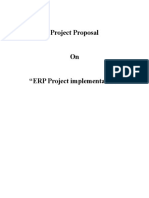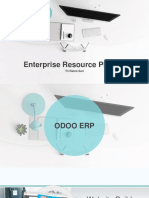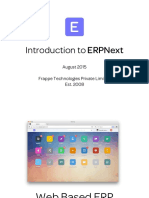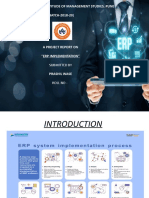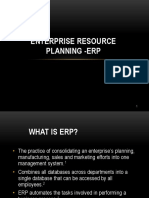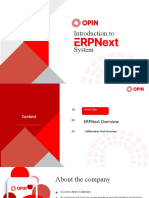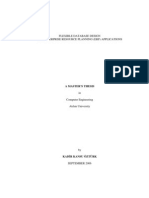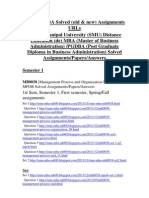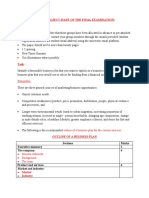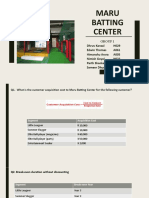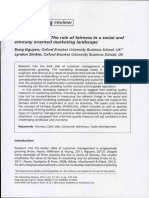Erp Implemetaion
Erp Implemetaion
Uploaded by
Jyoti PatilCopyright:
Available Formats
Erp Implemetaion
Erp Implemetaion
Uploaded by
Jyoti PatilCopyright
Available Formats
Share this document
Did you find this document useful?
Is this content inappropriate?
Copyright:
Available Formats
Erp Implemetaion
Erp Implemetaion
Uploaded by
Jyoti PatilCopyright:
Available Formats
MBA Project Synopsis / Proposal
Project Proposal On
ERP Project implementation
Prepared by Mr. Atanu Maity Roll No : 000-0000000 XXXX XXXX University
For Project Report of this project email at info@readymadeproject.com
Provided by
http://www.programmer2programmer.net http://www.readymadeproject.com
PAGE
MBA Project Synopsis / Proposal
`
Table of Content
INTRODUCTION:..........................................................................................................3 OBJECTIVES:.................................................................................................................6 HYPOTHESIS:................................................................................................................6 METHODOLOGY:..........................................................................................................7 PRIMARY DATA:..........................................................................................................7 SECONDARY DATA:....................................................................................................7 BIBLIOGRAPHY: ..........................................................................................................7
Provided by
http://www.programmer2programmer.net http://www.readymadeproject.com
PAGE
MBA Project Synopsis / Proposal
`
ERP Project implementation
INTRODUCTION:
The initials ERP originated as an extension of MRP (material requirements planning; later manufacturing resource planning) and CIM (Computer Integrated Manufacturing). It was introduced by research and analysis firm Gartner in 1990. ERP systems now attempt to cover all core functions of an enterprise, regardless of the organization's business or charter. These systems can now be found in non-manufacturing businesses, non-profit organizations and governments.
To be considered an ERP system, a software package must provide the function of at least two systems. For example, a software package that provides both payroll and accounting functions could technically be considered an ERP software package
Examples of modules in an ERP which formerly would have been stand-alone applications include: Product lifecycle management, Supply chain management (e.g. Purchasing, Manufacturing and Distribution), Warehouse Management, Customer Relationship Management (CRM), Sales Order Processing, Online Sales, Financials, Human Resources, and Decision Support System.
Some organizations
typically those with sufficient in-house IT skills to
integrate multiple software products choose to implement only portions of an ERP system and develop an external interface to other ERP or stand-alone
Provided by
http://www.programmer2programmer.net http://www.readymadeproject.com
PAGE
MBA Project Synopsis / Proposal
` systems for their other application needs. For example, one may choose to use human resource management system from one vendor, and perform the integration between the systems themselves. This is common to retailers, where even a mid-sized retailer will have a discrete Point-of-Sale (POS) product and financials application, then a series of specialized applications to handle business requirements such as warehouse management, staff rostering, merchandising and logistics.
Ideally, ERP delivers a single database that contains all data for the software modules, which would include: Manufacturing Engineering, bills of material, scheduling, capacity,
workflow management, quality control, cost management, manufacturing process, manufacturing projects, manufacturing flow Supply chain management purchasing, product Order to cash, inventory, order entry, supply chain planning, supplier configurator,
scheduling, inspection of goods, claim processing, commission calculation Financials General ledger, cash management, accounts payable, accounts receivable, fixed assets Project management Costing, billing, time and expense, performance units, activity management Human resources Human resources, payroll, training, time and attendance, rostering, benefits Customer relationship management - Sales and marketing, commissions, service, customer contact and call center support Data warehouse - and various self-service interfaces for customers, suppliers, and employees Access control - user privilege as per authority levels for process execution
Provided by
http://www.programmer2programmer.net http://www.readymadeproject.com
PAGE
MBA Project Synopsis / Proposal
` Customization - to meet the extension, addition, change in process flow
Enterprise resource planning is a term originally derived from manufacturing resource planning (MRP II) that followed material requirements planning (MRP). MRP evolved into ERP when "routings" became a major part of the software architecture and a company's capacity planning activity also became a part of the standard software activity. ERP systems typically handle the manufacturing, logistics, distribution, inventory, shipping, invoicing, and accounting for a company. ERP software can aid in the control of many business activities, including sales, marketing, delivery, billing, production, inventory management, quality management and human resource management.
Provided by
http://www.programmer2programmer.net http://www.readymadeproject.com
PAGE
MBA Project Synopsis / Proposal
`
OBJECTIVES:
1. To study the advantages of ERP. 2. To study the steps required to successful ERP implementation. 3. To perform a to-do check and process implementation.
HYPOTHESIS:
1. Customer wants to implement ERP system. 2. Consumer wants to understand advantages and disadvantages of ERP
Provided by
http://www.programmer2programmer.net http://www.readymadeproject.com
PAGE
MBA Project Synopsis / Proposal
`
METHODOLOGY:
Study is going to be conducted in the ABC company in Mumbai.
PRIMARY DATA:
A questionnaire survey will be conducted for the purpose of the study. The study is based on primary as well as secondary data. Primary data will be collected from questionnaires at ABC company in Mumbai.
SECONDARY DATA:
Secondary data is the data, which is already in existence. It will be collected mainly through internet and some help will also be taken from books and articles.
BIBLIOGRAPHY:
1. Class A ERP Implementation: Integrating Lean and Six Sigma - by Donald H. Sheldon 2. Modern ERP: Select, Implement & Use Today's Advanced Business Systems - by Marianne Bradford 3. Maximizing Your ERP System: A Practical Guide for Managers - by Scott Hamilton 4. Enterprise Resource Planning
Provided by
http://www.programmer2programmer.net http://www.readymadeproject.com
PAGE
MBA Project Synopsis / Proposal
` - by Bret Wagner 5. www.wikipedia.org 6. www.sap.com 7. www.oracle.com 8. www.nasscom.com 9. www.google.com
Provided by
http://www.programmer2programmer.net http://www.readymadeproject.com
PAGE
You might also like
- ERP Next BrochureDocument2 pagesERP Next BrochureYusuf Mulinya100% (1)
- OPIN ERPNext HR Module Overview v1 05022023Document41 pagesOPIN ERPNext HR Module Overview v1 05022023Majeed Yusuf100% (1)
- Million Dollar Ad SwipesDocument8 pagesMillion Dollar Ad SwipesSike Thedeviant50% (12)
- Eleven Steps To Success - GLOBUS StrategyDocument4 pagesEleven Steps To Success - GLOBUS StrategyMyra100% (7)
- Odoo Feature List PDFDocument2 pagesOdoo Feature List PDFRejoy Radhakrishnan0% (1)
- ERP Project Report - SampleDocument23 pagesERP Project Report - SampleFaisal Jalal100% (1)
- Manufacturing Process in OdooDocument11 pagesManufacturing Process in Odoomaham100% (3)
- Erpnext PosDocument1 pageErpnext Posdtanonimo100% (1)
- Odoo HR PDFDocument17 pagesOdoo HR PDFRejoy Radhakrishnan100% (1)
- Manufacturing MRP White PaperDocument17 pagesManufacturing MRP White PaperRobert van Mill100% (1)
- Erp Architecture PDFDocument2 pagesErp Architecture PDFKeisha50% (2)
- Software License Optimization And Entitlement A Complete Guide - 2020 EditionFrom EverandSoftware License Optimization And Entitlement A Complete Guide - 2020 EditionNo ratings yet
- Indomie Noodles in Africa: Lessons On Digital and Cultural BrandingDocument11 pagesIndomie Noodles in Africa: Lessons On Digital and Cultural BrandingPetronella Ayu100% (1)
- Project Proposal OF ERPDocument7 pagesProject Proposal OF ERPsecurics50% (2)
- Enterprise Resource Planning (ERP) : Presented By: Makansingh ChauhanDocument28 pagesEnterprise Resource Planning (ERP) : Presented By: Makansingh ChauhanGuru Darshan0% (1)
- Project Management Issues in Implementing ERPDocument19 pagesProject Management Issues in Implementing ERPSamridh Agarwal100% (1)
- Bizglow Odoo Erp AbbasDocument11 pagesBizglow Odoo Erp AbbasMuhammad Imran HashmiNo ratings yet
- ERP Export ServiceDocument15 pagesERP Export Serviceslc lcb100% (1)
- ERP Implementation - 12 Steps To A Successful ERP PDFDocument34 pagesERP Implementation - 12 Steps To A Successful ERP PDFchandana100% (1)
- ERP Next: by Mohammed Ibrahim (1891029) Jaladhi Sonagara (1991106)Document12 pagesERP Next: by Mohammed Ibrahim (1891029) Jaladhi Sonagara (1991106)jaldhi sonagara100% (1)
- HRMS Systems MenuDocument3 pagesHRMS Systems MenuTaha Sanabani100% (1)
- Enterprise Resource Planing: Tri Ratna SariDocument15 pagesEnterprise Resource Planing: Tri Ratna SariTri Ratna SariNo ratings yet
- Erp NextDocument21 pagesErp NextPeniel Technology100% (1)
- FinalDocument29 pagesFinalsadiaf507100% (2)
- Odoo Functional Training v8 MRP PDFDocument8 pagesOdoo Functional Training v8 MRP PDFGeo BursucNo ratings yet
- ERP BROCHURE HealthcareDocument18 pagesERP BROCHURE Healthcareslc lcb100% (2)
- Functional Requirements Document For Microsoft Dynamics AX 2012Document50 pagesFunctional Requirements Document For Microsoft Dynamics AX 2012ismailameen20036160100% (1)
- Polyclinic ERP Modules and Dashboards: This Module Provides You With Following FeaturesDocument35 pagesPolyclinic ERP Modules and Dashboards: This Module Provides You With Following FeaturesHumza Ahmad100% (2)
- ERP Next BrochureDocument2 pagesERP Next BrochureYusuf MulinyaNo ratings yet
- Checklist Go Live (ERP)Document24 pagesChecklist Go Live (ERP)TamaraGarza100% (1)
- Erpnext-Customer Relationship Management (CRM) Workflow: WWW - Solufy.In Page No: 1Document7 pagesErpnext-Customer Relationship Management (CRM) Workflow: WWW - Solufy.In Page No: 1Lawes Chan100% (1)
- Erpnext Customize Related Git and UploadDocument4 pagesErpnext Customize Related Git and UploadVinod J Prakash100% (1)
- Introduction To Erpnext: August 2015 Frappe Technologies Private Limited Est. 2008Document13 pagesIntroduction To Erpnext: August 2015 Frappe Technologies Private Limited Est. 2008Henri Baudou100% (2)
- Microsoft Dynamics 365 Finance and Operation: ConsolidationDocument9 pagesMicrosoft Dynamics 365 Finance and Operation: ConsolidationSherif Keshta100% (1)
- CRM Whitepaper CRM TestingDocument2 pagesCRM Whitepaper CRM TestingBlacky Kettavan100% (1)
- Attendance Management - Odoo AppsDocument1 pageAttendance Management - Odoo AppsblackghostNo ratings yet
- Erpnext Introduction: Enterprise Resource Planning ToolDocument9 pagesErpnext Introduction: Enterprise Resource Planning ToolRST timedocto100% (1)
- ERP Next Brochure1Document2 pagesERP Next Brochure1Yusuf Mulinya100% (1)
- 03 ERP Development PlanDocument23 pages03 ERP Development PlanDr. Syed Masrur100% (1)
- ERP ImplementationDocument18 pagesERP Implementationvrsirsath0% (1)
- ERPNext Learning GuideDocument31 pagesERPNext Learning GuideAhmed AL-Farran100% (1)
- (BATCH-2018-20) : Chetan Dattaji Gaikwad Institude of Management Studies, PuneDocument8 pages(BATCH-2018-20) : Chetan Dattaji Gaikwad Institude of Management Studies, PuneRubina MansooriNo ratings yet
- Ernext SellingDocument14 pagesErnext SellingLawes ChanNo ratings yet
- ERPNext DocumentationDocument13 pagesERPNext DocumentationSree Eedupuganti100% (1)
- ERPPDocument67 pagesERPPابراهيم معوضة100% (1)
- Logipulse BrochureDocument12 pagesLogipulse BrochureManoj Kumar Meena100% (1)
- C Enterprise Resource PlanningerpDocument11 pagesC Enterprise Resource Planningerpchittesh23100% (1)
- OPIN ERPNext Introduction v3 0502023Document24 pagesOPIN ERPNext Introduction v3 0502023Majeed Yusuf100% (1)
- SAP ERP Implementation CommercialDocument12 pagesSAP ERP Implementation CommercialAna PetekNo ratings yet
- ERP Feature Comparison GuideDocument25 pagesERP Feature Comparison GuideElio Chamate100% (1)
- Kinisi ERPNext Solution. (26 - 08 - 21)Document17 pagesKinisi ERPNext Solution. (26 - 08 - 21)Hari Arumugam100% (1)
- ERPDocument89 pagesERPJack AbdallahNo ratings yet
- Basic Coding Guide For Frappe - ERPNextDocument22 pagesBasic Coding Guide For Frappe - ERPNextIwan100% (1)
- Integrating+Primavera+P6+With+Oracle+ERP+ +Which+Technology+Path+is+Right+for+YouDocument43 pagesIntegrating+Primavera+P6+With+Oracle+ERP+ +Which+Technology+Path+is+Right+for+Yousagar.biswas.079983No ratings yet
- All You Need To Know About Odoo's PartnershipDocument28 pagesAll You Need To Know About Odoo's PartnershipEric Teo100% (2)
- Erp Implementation Cost CalculatorDocument1 pageErp Implementation Cost CalculatorIngrid Andra BăjenaruNo ratings yet
- Inventory Usage SampleDocument20 pagesInventory Usage SampleDịu NguyễnNo ratings yet
- Proposal For Radius ERP Hospital ManagementDocument14 pagesProposal For Radius ERP Hospital ManagementAmarnath GuptaNo ratings yet
- Public Cloud ERP for Small or Midsize Businesses A Complete Guide - 2019 EditionFrom EverandPublic Cloud ERP for Small or Midsize Businesses A Complete Guide - 2019 EditionNo ratings yet
- BlackBook A Study On Equity in FMCG SectorDocument68 pagesBlackBook A Study On Equity in FMCG SectorMayur KantariaNo ratings yet
- SMU MBA Solved (Old & New) Assignments URLsDocument95 pagesSMU MBA Solved (Old & New) Assignments URLsSatya ThirumaniNo ratings yet
- 50 Admired Companies To Watch 2020Document68 pages50 Admired Companies To Watch 2020The CEO ViewsNo ratings yet
- SUMMER TRAINING REPORT KoyalDocument69 pagesSUMMER TRAINING REPORT KoyalNARENDERNo ratings yet
- Fan Fest Letter Request 1Document2 pagesFan Fest Letter Request 1api-76345244No ratings yet
- Best Integrated Campaign Tata Tea - Jaago ReDocument20 pagesBest Integrated Campaign Tata Tea - Jaago RemaithilibanerjeeNo ratings yet
- Master of Science: Programs in ManagementDocument34 pagesMaster of Science: Programs in ManagementRaj PeddisettyNo ratings yet
- Information Processing Perspectives Adult Ad Kids Ad PerceptionDocument4 pagesInformation Processing Perspectives Adult Ad Kids Ad PerceptionAdityansu SumanNo ratings yet
- A Study On Consumer's Purchasing Intention Towards Eco-Friendly ProductsDocument9 pagesA Study On Consumer's Purchasing Intention Towards Eco-Friendly Productsamit1002001No ratings yet
- Consumer EquilibriumDocument10 pagesConsumer EquilibriumHimanshuChorasamaNo ratings yet
- Comparison of Cadbury With CompetitotsDocument56 pagesComparison of Cadbury With CompetitotsdeeptiNo ratings yet
- Ent 207 Business Plan Project DevelopmentDocument2 pagesEnt 207 Business Plan Project DevelopmentAlvin KoechNo ratings yet
- Green Book-BBA - 2023Document25 pagesGreen Book-BBA - 2023Leo AnimeNo ratings yet
- Marketing Kotler&Amstrong CHP 9Document23 pagesMarketing Kotler&Amstrong CHP 9sejin cho100% (1)
- Case Study of E-Commerce Payment SystemDocument32 pagesCase Study of E-Commerce Payment Systemnazzib89% (9)
- Maru Batting CaseDocument10 pagesMaru Batting CasePerpetual LearnersNo ratings yet
- Visionary CompassDocument77 pagesVisionary CompassAyobami FelixNo ratings yet
- A Study On Impact of Branding On Consumer Behaviour Towards Volkswagen in Coimbatore CityDocument68 pagesA Study On Impact of Branding On Consumer Behaviour Towards Volkswagen in Coimbatore CityAshwin KumarNo ratings yet
- Marketing ReviewDocument13 pagesMarketing ReviewGoran TesicNo ratings yet
- Funnel U33Document20 pagesFunnel U33nguyentanhaiNo ratings yet
- Personal Selling 1Document13 pagesPersonal Selling 1Sunil SewakNo ratings yet
- Haleeb 1Document97 pagesHaleeb 1Imran Hassan100% (1)
- Consumer Behaviour On Toothpaste ColgateDocument33 pagesConsumer Behaviour On Toothpaste ColgateShahnawaz Aadil20% (5)
- Why Selling and Salesmanship Is Important To Study For The Students of Business Administration?Document5 pagesWhy Selling and Salesmanship Is Important To Study For The Students of Business Administration?king jafrinNo ratings yet
- SWR Tyre Auto ServicesDocument16 pagesSWR Tyre Auto ServicesMUHAMMAD NUUR AMIN BIN TALIBNo ratings yet
- APTECH COMPUTER EducationDocument25 pagesAPTECH COMPUTER Educationatharnawaz110No ratings yet
- Operations Management With TQMDocument70 pagesOperations Management With TQMShenShen LynwellNo ratings yet














